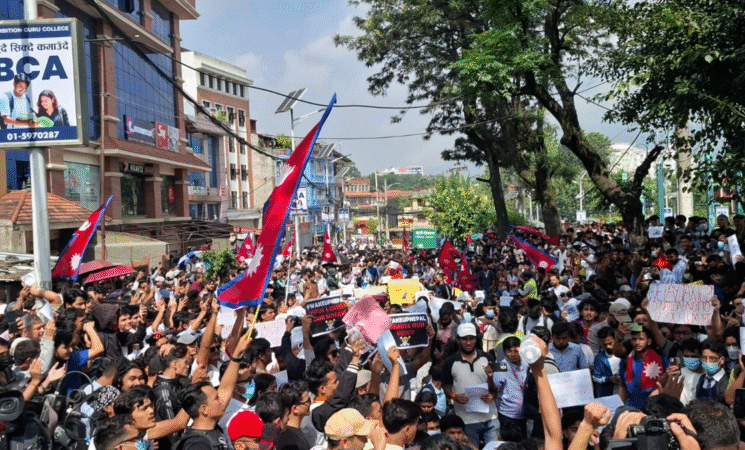15 September 2025, NIICE Commentary 11733
Manila Prajapati
The streets of Kathmandu city are once more the theater of democratic hope as Nepali youth, in thousands, angry at corruption and government incompetence, have emerged onto the streets in unprecedented protests. Within less than 48 hours, it had turned into a mass movement for political change, accountability, and transparency. These demonstrations are not so much an intranational disruption; they are a sign of something wider, a redefinition of the ways in which democracy is contested, questioned, and defended throughout South Asia. Nepal's case in this context has particularly valuable lessons to offer on the evolving dynamics of democracy promotion in South Asia, where youth movements are increasingly determining political trajectories.
Historical Background
The democratic transition in Nepal has been long and turbulent. Two most significant milestones worthy of mention are the 1990(2047 B.S). The People's Movement, which led to the abolition of absolute monarchy and the establishment of multiparty democracy, and the 2006 (2062/63 B.S) movement, which removed the monarchy and established a Federal Democratic Republic in 2008. A new constitution went into force in 2015, guaranteeing federalism and other reforms. However, despite these advances, Nepal still suffers from bad institutions, corruption, and poor accountability. Faith in traditional parties has decreased, especially among young people. These ongoing protests are a continuation of the long-standing tradition of citizens standing up and demanding change. The only difference here is that Gen Z have participated, who are also digitally educated and stake their legitimacy on moral claims as well as mass mobilization.
Anatomy of the Current Protests
On September 4, the Nepalese government imposed a ban on social media that had failed to register with the Ministry of Communication and Information Technology within the required time frame, which acted as a catalyst for this protest. After the ban, frustrations of decades-old relating to misuse of state resources, children and influential individuals enjoying benefits, sharing photos and videos of luxury cars, foreign education, and expensive holidays funded by corruption had been brewing among youth. This anger found expression in mass actions led primarily by students and young professionals. Hami Nepal advocated for justice using its Instagram account, raising concerns about the safety of Nepali students. It initiated the #youthsagainstcorruption campaign on social media, which gained rapid momentum and led to the rally on 8 September 2025. This protest led to the resignation of Prime Minister K.P. Oli and other ministers too.
Nepal's Gen-Z Protest in the Regional Context
These protests are not a singular event; they are part of a broader phenomenon of south asian youth looking for change because they are outraged by corruption, inequality, and governance failure. In Bangladesh, the student-initiated 2024 quota reform movement contested an unyielding job reservation policy eroding meritocracy and pointing to pervasive discontent with governance failure. Before this, in Sri Lanka, the 2022 Aragalaya movement was born out of economic collapse and large-scale corruption, resulting in a sitting president resigning from office following weeks of street occupations by youth and civic action. All these movements share a common economic uncertainty, dissatisfaction with corruption, and creative use of digital space for mobilization. Youth are determined to bring about change. Nepal's Gen Z protests are a part of a broader trend in South Asia, where young people are becoming a significant voice for democracy, demanding change in processes that can be resistant to it. They're getting politicians to listen to them, no matter how hard.
Protests and Lessons in Democracy for the Region.
In Nepal, the protests have opened up civic space, calling for more transparency and accountability in government. They have also demonstrated that there is a crisis of legitimacy of traditional parties, and young people want to play meaningful political roles. But the protests also present challenges, including threats of violence and leadership issues. Regionally, Nepal protests demonstrate growing youth power in South Asian democracy. They are using digital space to bring change and to push for accountability. The protests also demonstrate that international networks, civil society are crucial for empowering these movements. Individuals who wish to help democracies must be involved in helping youth movements at the local level, not merely with governments or top leaders. Protests in Nepal signal that the future of South Asian democracy will be shaped by the dynamism and innovation of its youth. It conveys that digital freedom is essential in a healthy democracy and that governments have to be attentive as well as sensitive towards the interests of youth and disadvantaged groups.
For countries like India, China, and Western donors who want to support democracy, Nepal's experience means that fine-tuning is very crucial. They should encourage democratic forces without meddling in Nepal's sovereignty and without exerting external influence that would dilute local ownership and self-determination. It is a reminder that effective democracy promotion has to respect those complexities.
Recommendations
For Nepal, the upcoming elections will be a critical test of whether the state has learned from the Gen Z protests and can restore public trust in democratic institutions. The government and the Election Commission of Nepal must ensure freedom of expression, make transparent regulation of online platforms, and prevent any arbitrary shutdown of digital media during the campaign period. To conduct free and fair elections, the Election Commission of Nepal should be more independent and transparent. This can be done by monitoring vote-buying and making the disclosure of the sources of funds by candidates mandatory. This would maintain transparency and accountability in the election process. Additionally, South Asian countries should also offer platforms where young people can share their experiences and work together on issues like democracy, governance, and digital rights. This would help foster collaboration and understanding across borders.
Conclusion
Nepal Genz protests are not unique but a part of a wider regional and international wave of protests calling for accountability, transparency, and democracy. They reflect a new generation of political participation, as young people are now emerging in numbers to protest against the existing institutions and call for reform.

